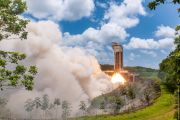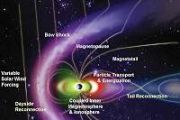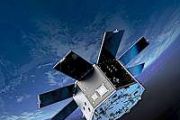
Copernical Team
NASA Advances Work on NEO Surveyor Asteroid-Hunting Spacecraft
 NASA's Jet Propulsion Laboratory (JPL) is making significant progress on the NEO Surveyor, a next-generation infrared space telescope designed to detect asteroids and comets that could potentially threaten Earth. This mission marks the agency's first space telescope dedicated to planetary defense.
Scheduled for launch in late 2027, NEO Surveyor will be stationed a million miles away at the
NASA's Jet Propulsion Laboratory (JPL) is making significant progress on the NEO Surveyor, a next-generation infrared space telescope designed to detect asteroids and comets that could potentially threaten Earth. This mission marks the agency's first space telescope dedicated to planetary defense.
Scheduled for launch in late 2027, NEO Surveyor will be stationed a million miles away at the Martian Ice Caps Reveal Insights into Ancient Climate Shifts
 Katherine Lutz, a PhD student at the Guarini School of Graduate and Advanced Studies and National Science Foundation Fellow, began her journey in planetary science by examining satellite images of Mars' polar ice caps. These images revealed spiraling patterns across the ice caps, which are composed of alternating layers of ice and dusty deposits and range between 400 to 1,000 meters deep. These
Katherine Lutz, a PhD student at the Guarini School of Graduate and Advanced Studies and National Science Foundation Fellow, began her journey in planetary science by examining satellite images of Mars' polar ice caps. These images revealed spiraling patterns across the ice caps, which are composed of alternating layers of ice and dusty deposits and range between 400 to 1,000 meters deep. These Highest-Resolution Black Hole Images Captured by Event Horizon Telescope
 The Event Horizon Telescope (EHT) Collaboration has achieved the sharpest images ever captured from Earth, detecting light from the centers of distant galaxies at a frequency of around 345 GHz. This milestone represents the highest resolution obtained in ground-based astronomy.
These new observations, combined with previous images of supermassive black holes at the lower frequency of 230 G
The Event Horizon Telescope (EHT) Collaboration has achieved the sharpest images ever captured from Earth, detecting light from the centers of distant galaxies at a frequency of around 345 GHz. This milestone represents the highest resolution obtained in ground-based astronomy.
These new observations, combined with previous images of supermassive black holes at the lower frequency of 230 G HKU Geologists Uncover Extensive Intrusive Magmatism at Chang'e-6 Lunar Site
 Lunar igneous activities, including both intrusive and extrusive magmatism, offer crucial insights into the Moon's interior and its thermal history. These activities are distributed asymmetrically between the Moon's nearside and farside, reflecting the global lunar dichotomy. Previous lunar samples returned by Apollo, Luna, and Chang'e-5 missions all originated from the nearside, leaving a gap i
Lunar igneous activities, including both intrusive and extrusive magmatism, offer crucial insights into the Moon's interior and its thermal history. These activities are distributed asymmetrically between the Moon's nearside and farside, reflecting the global lunar dichotomy. Previous lunar samples returned by Apollo, Luna, and Chang'e-5 missions all originated from the nearside, leaving a gap i NASA's Advanced Solar Sail Successfully Deploys in Space
 NASA's Advanced Composite Solar Sail System has successfully completed the deployment of its sail-hoisting boom system, marking a key milestone for the mission. The confirmation of this achievement came at 1:33 p.m. EDT (10:33 a.m. PDT) on Thursday, Aug. 29, after mission operators received telemetry data from the spacecraft. Four onboard cameras captured a sweeping view of the reflective sail a
NASA's Advanced Composite Solar Sail System has successfully completed the deployment of its sail-hoisting boom system, marking a key milestone for the mission. The confirmation of this achievement came at 1:33 p.m. EDT (10:33 a.m. PDT) on Thursday, Aug. 29, after mission operators received telemetry data from the spacecraft. Four onboard cameras captured a sweeping view of the reflective sail a NASA and Boeing Prepare for Uncrewed Starliner Return Mission
 NASA and Boeing teams have completed a comprehensive Delta-Flight Test Readiness Review, giving the green light for the uncrewed CST-100 Starliner spacecraft to undock from the International Space Station. The undocking is scheduled for no earlier than 6:04 p.m. EDT on Friday, Sept. 6, depending on weather and operational readiness.
Once Starliner undocks, it will take approximately six ho
NASA and Boeing teams have completed a comprehensive Delta-Flight Test Readiness Review, giving the green light for the uncrewed CST-100 Starliner spacecraft to undock from the International Space Station. The undocking is scheduled for no earlier than 6:04 p.m. EDT on Friday, Sept. 6, depending on weather and operational readiness.
Once Starliner undocks, it will take approximately six ho European drill and mini lab secure ride to the Moon

ESA's Prospect package, including drill and a miniaturised laboratory, will fly to the Moon’s South Polar region in search of volatiles, including water ice, as part of NASA’s Commercial Lunar Payload Services initiative.
Discover where space begins: the guide to ESA’s establishments

Discover where space begins: the guide to ESA’s establishments
Blue Origin completes latest space tourism flight
 Blue Origin flew its latest group of six thrill-seekers to the edge of space and back again Thursday, including the youngest-ever woman to complete the feat.
Mission NS-26 marked the eighth human spaceflight for the company, founded by Jeff Bezos, as it presses ahead in the emerging suborbital tourism market.
Karsen Kitchen, a 21-year-old senior at the University of North Carolina at Cha
Blue Origin flew its latest group of six thrill-seekers to the edge of space and back again Thursday, including the youngest-ever woman to complete the feat.
Mission NS-26 marked the eighth human spaceflight for the company, founded by Jeff Bezos, as it presses ahead in the emerging suborbital tourism market.
Karsen Kitchen, a 21-year-old senior at the University of North Carolina at Cha Blue Origin completes latest space tourism flight successfully

Blue Origin flew its latest group of six thrill-seekers to the edge of space and back again Thursday, including the youngest-ever woman to complete the feat.
Mission NS-26 marked the eighth human spaceflight for the company, founded by Jeff Bezos, as it presses ahead in the emerging suborbital tourism market.
Karsen Kitchen, a 21-year-old senior at the University of North Carolina at Chapel Hill, became the youngest woman ever to cross the Karman Line, the internationally recognized boundary marking the edge of space, 100 kilometers (62 miles) above the Earth's surface.
Blue Origin's small New Shepard rocket blasted off at 8:00 am local time (1300 GMT) from the company's Launch Site One base in west Texas.
After liftoff, the sleek and spacious capsule separated from its booster, which boasts zero carbon emissions, before the rocket performed a precise vertical landing.

































